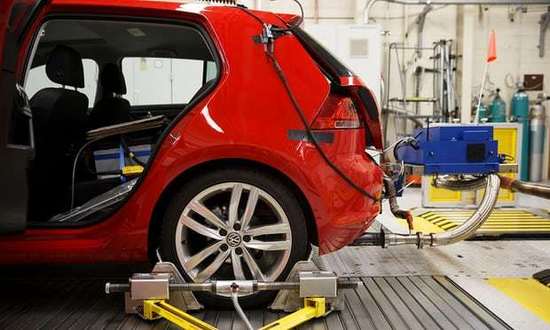(Original caption: How can we stop algorithms telling lies?)

How does the algorithm organize your data?
Netease Technology News July 20, "The Guardian" website wrote that the algorithm can determine whether you can apply for a home loan, but also can determine how much you want to pay insurance costs, but sometimes they will make mistakes - and sometimes They are specifically used for fraud. So how do you stop the algorithm from being deceptive?
The following is the main content of the article:
Many algorithms will inadvertently do evil. However, some algorithms are used for criminal activities. Algorithms are formal rules that are usually written in computer code and can predict future events based on historical patterns or past patterns. To train an algorithm, you need to provide historical data and successful definitions.
Over the past few decades, you can see that some financial activities have been taken over by algorithms. Trading algorithms use historical data to predict future market trends. The success criterion of this kind of algorithm is whether it can bring about predictable market trends, and the algorithm will be wary of the historical laws before the occurrence of that trend. The financial risk model also uses historical market changes to predict major changes on a global scale, not for independent stocks but for an entire market. The bad model for mortgage-backed securities—namely deliberately created—trusted those models as culprits for the huge losses caused by the 2008 financial crisis.
Since 2008, we have heard more about big data algorithms than financial ones. The goals of this new generation of algorithms have shifted from abstract markets to individuals. But its basic function is the same: collect historical data about people, record their online behavior, location, or responses to surveys, and then use huge datasets to predict their future spending activities, voting behavior, or professional ethics.
In recent years, the widespread adoption of big data models has hardly caught the attention of ordinary people, but it can be said that some important moments in which people come in contact with large bureaucratic systems involve scoring systemic algorithms. University admissions, job seekers screening, employee performance assessments, credit card applications, insurance purchases, voting for elections, and even policing are often accomplished through algorithms. In addition, the techniques that are applied to these system decisions are largely untransparent (even opaque to their creators) and are currently largely able to escape regulation even if they have problems. This makes it more important and urgent to ask which of these algorithms are really serving us.
Four levels of algorithm
Speaking of evil algorithms, I divided them into four levels. The highest level is the unexpected problem that reflects cultural prejudices. For example, Harvard professor Latanya Sweeney found that searching Google for a name that is considered a black name would generate advertisements related to criminal activities, but we can assume that no Google engineers wrote those racisms. The code. In fact, the reason why those bad advertisements appear is because of previous users' training of Google search behavior data: they are more likely to click on criminal record advertisements after the search sounds like a black name. Another example is: Google search for "professional hairstyle" pictures, the results are almost all black women's pictures, this is also because of people's post or search results click behavior data training results.
The next level is a bad algorithm because of negligence. The algorithm here includes a scheduler that does not allow decent living for those working in the minimum wage. These algorithms regard them as a gear of the machine and arrange them to have different shifts on each day of each week, making them unable to work properly, and therefore cannot usually take care of children, can no longer take a job, or cannot study at night school. They have achieved a high degree of efficiency and scale in a cruel manner and are generally legal. The same is true of Google’s system for automatically tagging photos. The system has always had a problem: Blacks are labeled as gorillas. This shows that the company is negligent and does not do enough on the quality assessment of the product itself: they did not make sure they were not problematic in various test cases before releasing the code.

Algorithms are used to screen job seekers without a manual review of resumes, which may lead to discrimination
The third level contains bad but not illegal algorithms. For example, in Australia, Facebook executives are showing advertisers ways to find and target disadvantaged young people. This is terrible, but it does not seem to be illegal. Indeed, online advertising can be broadly viewed as a spectrum: On the one hand, luxury advertisements are presented to wealthy people to attract them to click on purchases; on the other hand, they are presented to poor people and desperate people. advertising. For those who are unlikely to shop around, the algorithm will charge higher car insurance fees. Uber just discontinued an algorithm it uses to predict how low the salary will be. This algorithm will further increase the income gap between men and women.
Finally, the bottom level includes algorithms that deliberately commit evils or even flagrant violations. There are hundreds of private companies offering a wide range of surveillance tools, including dozens of UK. Those tools have been billed as a way to locate terrorists or criminals, but they can also be used to target and correct civil activists. Because those companies collect large amounts of data, their predictive algorithms and scoring systems can be used to filter out useful signals from noise. The illicit nature of this industry is being discussed, but secret action reporters recently discovered that middlemen representing Iran and South Sudan were able to buy such systems relatively easily.
The reference of mass exhaust valve
Closer to home, Uber has developed an algorithm called "Greyball" that is designed to prevent its taxi service from being discovered when it is illegally operating in the city. It uses data to predict which passengers will violate Uber's terms of service, or to predict which passengers are part of a secret government law enforcement officer. The warning signals collected by Greyball included using Uber apps multiple times during the day and using credit cards associated with police agencies.
So far, the most notoriously deliberately illegal algorithm that we have found is the algorithm used by Volkswagen to blind off the exhaust pollution test on 11 million vehicles worldwide. The algorithm conceals the actual nitrogen oxide emissions of those cars. The fact that the law allows 35 times the number. Although on the surface the public use cheating devices, the device is also an algorithm. The algorithm is trained to identify and predict the test environment and the road environment and can operate in different ways depending on the results of the environmental discrimination. Like Greyball, it intends to cheat.

In 2015, the e-commerce company Poster Revolution was convicted of using algorithms to collaborate with other poster vendors.
The automotive manufacturer's example is worth pondering because of the algorithmic industry - it is a very young, high-risk new industry, but no security measures are deployed - very similar to the early automotive industry. The industry generally innocently believes in its own technology, but in reality, the AI ​​industry is currently selling cars that have no bumpers and whose wheels may fall off at any time. I am sure that people from time to time produce such cars, but over time, problem design has led to more and more casualties. We have come up with more regulations to protect passengers and pedestrians. Therefore, what lessons can we learn from the current mature automotive industry for illegal software and algorithms?
First, other car manufacturers other than the Volkswagen have also deployed similar software to close the emission control system under certain conditions. In other words, falsification of exhaust gas detection is not a case, but a set of standard operating procedures. In addition, we can assume that this is not a conspiracy, but rather a simple case of automakers being driven by extreme incentives and a low probability of being discovered. Then, we have every reason to believe that there are many other algorithms used to bypass the rules that are considered to be too costly to comply with, especially when the developers of these algorithms are not convinced of the probability of being discovered.
Then, the fraud of Volkswagen's exhaust testing began in 2009, which meant that it had not been discovered for a full five years. What happened in these five years? We started from this idea and thought about what companies are now defrauding regulators, circumventing privacy laws, or deliberately resorting to algorithmic fraud?
Based on cost-benefit analysis, this may be like an easy business model: cheating until it is discovered by regulators, and then paying a limited amount of fines that will not harm our accumulated profits. After all, it is also the mode of operation after the financial crisis. For shareholder value, we may have to do this.
From another perspective, we are all looking forward to the arrival of driverless cars in the coming years or at most a few decades later. At that time, can we expect the appearance of the ethic of the driverless car embedded in the international agreement? Or do you think that when a driverless car encounters an unexpected hole, the life and death of a pedestrian will be dominated by car manufacturers? If we pass the relevant regulations, will they be different in different countries? Even in accordance with the manufacturer's country to implement different regulations?
If observing things like car collisions is so confusing that it sounds ridiculous, imagine how difficult it would be to observe the underlying conditions in the vague world of complex "deep learning" models.
Of course, all the necessary tools are already available. Recent demonstrations in China have shown that facial recognition technology is quite good - enough to catch people who are crossing the road and stealing toilet paper. That means that companies have many opportunities to implement unfair tricks on customers or potential employees. On this issue, companies also have the business motivation to do so. Just last month, Google was heavily penalized by the EU for 2.4 billion euros because of its own shopping services in search results. Last year, Amazon was also sued by ProPublica for pricing algorithms. It was allegedly given priority in displaying self-operated products, although those products did not have a product cost outside of its market platform. If the Internet is where big data companies fight for your attention, then it is conceivable that more algorithms will be used for this purpose in the future.
There is also a place where the public exhaust scandal can learn. Its tail gas detection fraud was eventually discovered in 2014 by a team of professors and students at West Virginia University. The team applied for funding from the independent non-profit organization International Clean Transport Committee and received only $50,000 in the end. They used the money to drive cars around the country and capture emissions data on the way. This can be a very low-cost and straightforward test.

In 2015, Volkswagen was found to use counterfeit algorithms to detect false emissions
How to monitor the algorithm?
What kind of organization will curb the problem of impending illegal algorithm proliferation? Does the algorithmic field have the role of playing the role of the International Council for Clean Transportation? Is there an organization with sufficient qualifications, interests and abilities to stop illegal algorithms and prove that these algorithms are harmful? The answer is not yet available. In contrast, at least in the United States, irrelevant federal agencies are responsible for law enforcement issues in the area of ​​algorithms, but none of these organizations are particularly familiar with the intricacies of big data algorithms. In other regions, the European Commission seems to be focusing on investigating Google’s antitrust activities and Facebook’s fake news issues, but this has left many industry sectors uncensored.
However, the more important question is how deep the algorithm has been investigated. The current algorithm is a secret, belongs to proprietary code, and is protected as the company's "secret." They are too mysterious and many online scoring systems are not even transparent to the people they are targeting. That means that those people do not know how many points they have been awarded, nor can they complain or protest those points. The most important thing is that even if something unfair happened to them, they usually do not know it.
Taking all these issues into consideration, it is hard to imagine how to supervise the algorithm, even if they are wrong and continue to injure people. For this issue, first of all, not any kind of injury can be measured with absolute certainty. Some people may say that because of the proliferation of false news, our democracy has been damaged. But how do you measure democracy?
It does not mean that the algorithm is completely unsupervised. After all, by definition, illegal algorithms count as violations of the laws we can point out. In the final analysis, such violations should also be attributed to someone. However, the question of how to enforce such laws still exists.
Ben Shneiderman, a professor of computer science at the University of Maryland, presented the concept of the National Algorithm Safety Committee at a seminar at the Alan Turing Institute. The agency, modeled on the US National Transportation Safety Board for land and air traffic accident investigations, is similarly responsible for investigating damage caused by illegal algorithms, and in particular determining who should be responsible for the damage caused by the algorithm.

The algorithm used the historical data to estimate the value of the home. A US homeowner sued Zoopla for using the wrong data to reduce her property valuation by $100,000.
this is a good idea. We should investigate them when we find problems. A formal investigation process is a good thing. If the committee has sufficient legal authority, it may be able to dig into a lot of common sense issues. However, it is unclear how widespread its legal power will be.
To analogize with a car manufacturer's failure: In the algorithmic world, there is no similar situation in which the 30 cars collide. Most of the algorithmic harms happen silently to separate individuals. Compared to the car-collision accidents that are visible to the naked eye, many simultaneous, silent and undetectable car collisions are more difficult to investigate.
I still think that the investigation of the damage caused by the algorithm is promising. One of the miracles of being a data skeptic in the world of data evangelists is that people are overly amazed by their technology, and even when it inadvertently causes damage, they publicly describe how magical it is. We have seen not a few algorithmic damage cases, which means that although these algorithms are mysterious and opaque, they will eventually be rediscovered, although they have caused a lot of trouble.
What does this mean for the future? First of all, we need to start paying attention to all kinds of trends. Every illegal algorithm we find should be considered a test case. Is the offender in trouble? How much trouble does it fall into? Are those regulations implemented? What is the penalty? As we learned after the 2008 financial crisis, if the costs of violating the rules are lower than the benefits, the rules will be ignored.
Arms race
Once law enforcement and tracking are started, we are equivalent to entering an arms race. It can be expected that various mature algorithms will emerge soon. They can bypass the law, advanced, and quietly seek to evade the rules and regulations. They will learn from other caught algorithms and strive to do more perfect next time. In other words, it will become increasingly difficult to seize them for cheating. Our strategy must also be more sophisticated.

Predictive policing algorithms use historical data to predict where the next criminal offense will occur, and civil rights organizations say these systems amplify existing police biases.
We expect that it may also be informed by big companies that they are “handling privately.†This is already happening in the fight against terrorism. We should not trust them when they say so. We need to create a standard inspection framework - a standard definition of damage - and ask the submission algorithm to detect it. We cannot do this test only in "test laboratory conditions", otherwise there will be events like the mass exhaust valve in the field of algorithms.
One of the biggest obstacles to algorithm detection is that Google, Facebook, or Amazon does not allow external researchers to detect multiple role models (or personal online profiles). Because those companies customize and provide personalized services, the only way to understand how those services work is to view multiple people's files, but this is not allowed. Taking the analogy of mass exhaust testing is equivalent to saying that the research team has no control over the car and cannot detect its emissions. We need to ask for more access and continuous monitoring, especially when we catch them having wrongdoing. For this issue, the entire industry, such as insurance algorithms and recruitment algorithms, should be subject to such monitoring, not just to independent criminals.
It is time we are ready to fight. This battle will eventually become a technological arms race, but at the beginning, now it is a political battle. We need to ask practitioners to provide evidence that it may harm the fair, legal and consistent operation of our algorithm. When problems are discovered, we need to effectively enforce our laws and impose large fines on companies that violate the law, so that fraudulent activities can be made cost-effective and prevent them from happening. It is time to start asking for machines to work for us, not for us. (Lebang)
Explosion-proof Screen Protector
The Explosion-proof Screen Protective Film for mobile phones is a protective film that can effectively buffer the impact, prevent the screen from bursting, or prevent the glass panel from being broken and scattered due to accidental impact of the mobile phone. Screen protector with gloss, texture and surface hardness.
The Protective Film is made of imported materials from Korea. It is equipped with a proprietary "self-healing" function that can automatically repair minor scratches on the film. Daily protection measures to prevent accidental knocks and drops. The screen strengthens the screen and reduces the chance of cracking. Broken tempered glass is no longer replaced frequently.
1. Edge coverage: The Explosion-proof Screen Protector is made of PET flexible material, which is very suitable for the screen of your device, and 100% provides excellent edge coverage, and there is no gap between the edges of the device
2. High-definition resolution: high-definition display, true display of the original screen color.
3. Original touch experience: The oleophobic coating surface of the screen protector can provide your phone with original texture and perfect touch screen response speed. The PET Screen Protector also has oleophobicity and water resistance, which can prevent unnecessary fingerprints.
4. Self-repairing scratches: The Explosion-proof Protective Film with self-repairing function can automatically repair tiny scratches and bubbles within 24 hours.
5. Anti-seismic and explosion-proof: PET material has high strength, flexibility and elasticity, which can fully decompose the impact force and prevent the mobile phone from breaking.
PET Screen Protector, Explosion-proof Screen Protector, Explosion-proof Screen Protective Film, Explosion-proof Protective Film
Shenzhen Jianjiantong Technology Co., Ltd. , https://www.morhoh-sz.com